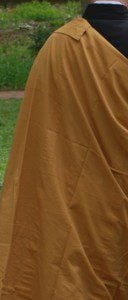 “Lose your body beneath the patched robe” is a line from a Stonehouse poem (p. 11), brought to us by the great translator, Red Pine. The patched robe refers to the kesa (or o’kesa for those of the Irish persuasion), the top garment worn by those committed to full time practice since the time of the Buddha.
“Lose your body beneath the patched robe” is a line from a Stonehouse poem (p. 11), brought to us by the great translator, Red Pine. The patched robe refers to the kesa (or o’kesa for those of the Irish persuasion), the top garment worn by those committed to full time practice since the time of the Buddha.
Stonehouse, a 14th Century Chinese Ch’an master, was one of the transmitters of Ch’an to Korea via one of his students. He also had a deep love for the solitude of his mountain hermitage.
I deeply love reading the poems of hermit monks, especially just before sleep. Last night the line, “Lose your body beneath the patched robe,” jumped up and off the page and into this blog post as a wonderful expression of the practice of home leaving.
Losing the body is one way that home leaving goes upstream, against the currents of the culture, generation after generation. Robes and bowls are usually used to support and maintain our lives. And although this is one practical aspect, of course, there is another aspect – losing the body.
We’re going to lose it anyway, of course, so why not practice diligently and realize that we’ve already lost it?
The significance of wearing robes and using bowls for our training, then becomes clear. Like a turtle, we carry our training container – the container we inherited – with us wherever we may go.
In becoming the robes and bowls, we hide ourselves in the formless form of living dharma. Losing ourselves we find that we express ourselves completely, no part left out.
The opportunity is the same, of course, if the robes happen to be t-shirt and jeans and the bowls are paper plates. When we lose ourselves in t-shirt, jeans and paper plates, the formless form of the kesa fills the ten directions.











